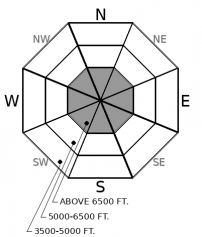| Monday | Monday Night | Tuesday | |
|---|---|---|---|
| Cloud Cover: | Partly Cloudy | Mostly Cloudy | Mostly Cloudy |
| Temperatures: | 20 to 26 deg. F. | 16 to 20 deg. F. | 24 to 27 deg. F. |
| Wind Direction: | Southwest | Southwest | Southwest |
| Wind Speed: | 9G25 | 20G40 | 22G44 |
| Snowfall: | 0" in. | 1" to 2" in. | 4" to 7" in. |
| Snow Line: | 2000' | 1500' | 1000' |
Whitefish Range
How to read the forecast
Though conditions are generally safe in the Whitefish Range, stack the odds in your favor by choosing safer terrain. Planar slopes with deeper, uniform snow cover are the cards you want to play. A few jokers - large avalanches that break near the ground - are isolated to steep, rocky, or convex slopes above about 6,000 feet.

1. Low
?
Above 6500 ft.
1. Low
?
5000-6500 ft.
1. Low
?
3500-5000 ft.
- 1. Low
- 2. Moderate
- 3. Considerable
- 4. High
- 5. Extreme
-
Type ?
-
Aspect/Elevation ?

-
Likelihood ?CertainVery LikelyLikelyPossible
 Unlikely
Unlikely -
Size ?HistoricVery LargeLargeSmall

Hard slabs that can break 2 to 4 feet thick on weak layers near the bottom of the snowpack are unlikely in the Whitefish Range, though there is some uncertainty about how much early season crusts and facets are gaining strength. Evidence that these layers remain unstable has been isolated to a few slopes above about 6,000 feet east of Whitefish Mountain Resort and in the northern part of the range. Persistent slab avalanches like these can be hard to predict. In these isolated areas choose planar slopes less than about 35 degrees. Avoid slopes with variable snow cover and shallow, rocky areas. Convex break-overs and unsupported slopes are other trigger point to watch out for.
Here we are, a week after Christmas and you’re cleaning up the decorations to transition into 2020. The excitement has been winding down since the Solstice. You’ve relaxed a little with not too much think about. But as you pack away the ornaments and look forward to the new year, you notice a lump in the bottom of your stocking. It’s a stale, almost-forgotten box of wafer cookies…
The last major avalanche activity in our area came and went with the storm on the 20th. Reports of large avalanches breaking on layers of crusts and weak facets came from near the Continental Divide and the northern Whitefish Range. More recently, the only feedback we’ve had from these persistent weak layers has been spotty. Snowpack tests continue to show that facets and crusts from November still have the potential to fail and propagate – except when they don’t. The inconsistency is because the facets are rounding and gaining strength as the slab above them thickens and hardens. New, hard crusts near the surface make it harder for you to affect the bottom of the snowpack. But not all the wafers are stale. On Friday, our neighbors in Fernie reported that a snowmobile remotely-triggered a large persistent slab avalanche in steep and rocky terrain.
So while the likelihood of triggering a big avalanche is down, the consequences remain high. You could find a stale cookie, or you could bite into a sweet spot where the sugary layers between the crusts are still weak and loose. Stay out of trouble by using the terrain to your advantage. Rather than betting it all by riding on just any old slope, choose wisely. The potential trouble lies on alpine slopes above about 6,000 feet in big, steep terrain where the snow cover varies in thickness. Convex break-overs and rocky outcrops are potential trigger points. You can find more slopes that meet that description in the Flathead Range and Glacier National Park.
People reported triggering small sluffs across the region over the weekend because 3-10 inches of light new snow that fell last week was bonding poorly to the underlying crusts. That problem is diminishing as the recent snow settles. But approach extreme terrain with an eye for consequences. Are there terrain traps where a small sluff could knock you off your feet and sweep you over a cliff or into trees?
Pacific moisture looks on tap for much of the coming week. If the weather forecast verifies this may be the last quiet day for a while. Expect the avalanche danger to rise as the ball drops on the new year.
Expect conditions to remain calm today, but change is on the way. Pacific moisture leads into Idaho and Montana tomorrow with moderate to heavy snow possible through Wednesday afternoon. Winds pick up from the southwest as a cold front pushes through our area by Wednesday morning.
This forecast applies only to backcountry areas outside established ski area boundaries. The forecast describes general avalanche conditions and local variations always occur. This forecast expires at midnight on the posted day unless otherwise noted. The information in this forecast is provided by the USDA Forest Service who is solely responsible for its content.




















